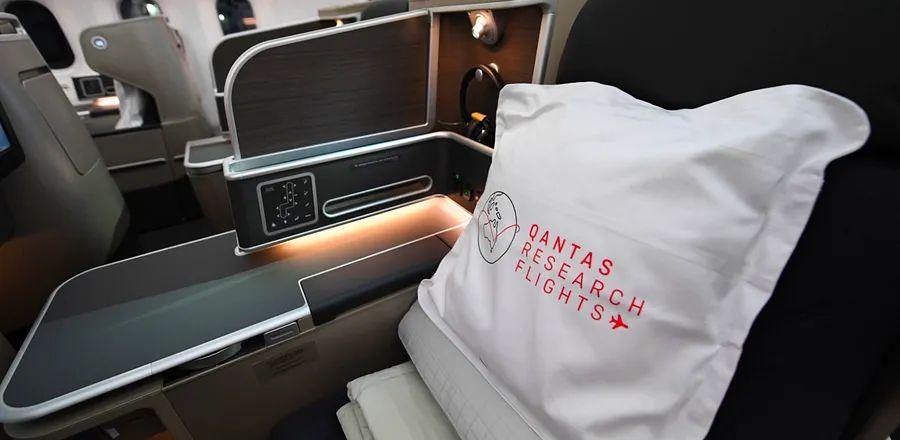A New Aircraft Could Be the Solution for Jet Lag

Disrupted sleep, irritability, and mental fog: Anyone who has traveled internationally has likely faced some symptoms of jet lag, which only intensify with each time zone crossed.
As international travel picks up in 2023 and 15-hour-plus 'ultra long-haul' flights return to airline schedules, it’s timely for one of the longest-haul carriers to revisit strategies for tackling this ongoing challenge.
Is there a magic formula to reduce, if not completely eliminate, the effects of jet lag? Qantas, which currently operates three of the five longest flights in the world (Perth–London, Melbourne–Dallas, and Auckland–New York), may have the solution. The airline has released findings from a study on traveler well-being during long flights and unveiled details about the aircraft it's designing in response: a state-of-the-art jumbo jet featuring a 'Wellbeing Zone' for in-flight exercises, along with specially designed seats, meals, and lighting. It’s set to debut on Qantas’s Sydney–New York nonstop service at the end of 2025.
The aircraft, an Airbus A350-1000 that has yet to be constructed, will serve as a flying laboratory to explore how airlines can enhance passenger well-being. At a recent media event in New York, Qantas CEO Alan Joyce likened the challenge of building a plane capable of carrying a full load for nearly 10,000 miles without refueling—1,000 miles further than any currently operating commercial flight—to a 'moon shot.' The jet will also operate on Qantas’s planned nonstop route between London and Sydney, launching after the New York premiere; at 10,573 miles and potentially lasting up to 22 hours, it is expected to become the longest flight in the world. These two lengthy routes are being promoted as 'Project Sunrise.'
With the introduction of these new flights, passengers may find themselves spending nearly a whole day in the air, Joyce remarked. “We have a long-standing tradition of leveraging creativity and innovation to bridge the distance between Australia and the rest of the world,” he stated. “Now that we possess the aircraft technology for these journeys, we want to ensure that the customer experience evolves alongside, which is why we’re conducting this research and rethinking our cabin design and service.”
In 2019, Qantas conducted test flights in collaboration with the Charles Perkins Centre at the University of Sydney, a health research institute, which involved 23 volunteers equipped with wearable technology and accompanied by a team of scientists on three flights lasting over 20 hours each. During these trips, the airline experimented with different onboard service strategies, including meal timing, lighting adjustments, and opportunities for passengers to move around the cabin.

Courtesy of Qantas
The recently released findings indicate that it's possible to mitigate the effects of jet lag "by transforming the inflight travel experience," the airline announced in a statement. One key insight was that the common practice of dimming the lights shortly after the first meal, which aligns with the departure city’s time, actually extends the adjustment period at the destination, according to Peter Cistulli, a sleep medicine professor at the University of Sydney involved in the study. The test flight demonstrated that scheduling a more extended rest period later in the journey significantly enhanced sleep quality and passengers’ cognitive functions upon waking, which was measured through games like “whack a mole.”
Cistulli expressed optimism, stating, "The early results are encouraging." The airline also trialed various mealtimes to help passengers recalibrate their internal clocks, even experimenting with specific ingredients like chile and chocolate. To promote the brain's production of tryptophan—an amino acid that aids sleep—the airline paired protein-rich foods such as fish and chicken with quick-digesting carbohydrates, along with comforting options like soups and milk-based desserts.
The A350-1000 aircraft will feature 100 fewer seats than the typical airline configuration, allowing for more legroom for all travelers, not just those in premium classes. Some of the additional space will be allocated to the proposed Wellbeing Zone for premium economy and economy passengers. This area is expected to accommodate six to eight individuals at a time, featuring sculpted wall panels and handholds for stretching, a hydration station with snacks, and a video displaying specific exercises. A spokesperson for the airline noted that details are still being finalized.

Courtesy of Qantas
The remainder of the new A350 aims to enhance passenger comfort as well. The first-class section will consist of six private suites, each offering a flat bed, a reclining chair, and a sizable dining table/desk that accommodates two people. Business-class travelers will enjoy personal privacy with sliding doors and lie-flat seats. Premium economy will feature a generous seat pitch of 40 inches, calf rests, and headrests with broad, eight-inch side wings. Even in economy, passengers will experience the airline’s most spacious seat pitch in that category, at 33 inches. Plus, every seat comes with an entertainment screen featuring Bluetooth connectivity and at least two fast-charging outlets.
Qantas’s research and testing aim to ensure that passengers in any cabin can enjoy enough comfort to combat jet lag and arrive at their destination feeling revitalized. Nevertheless, the best strategy for avoiding jet lag may be to treat yourself to one of those luxurious first-class suites up front.
Evaluation :
5/5



